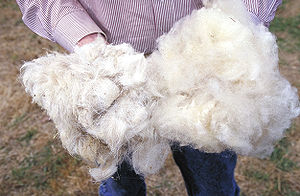Wool

Wool is the hair of certain mammals. Most wool comes from sheep and goats, but wool is also taken from camels, llamas, and special rabbits. Wool is a natural material. People use wool fiber to make clothing, blankets, and other things to keep warm. It is usually used to make outer clothing but is also used to make blankets, socks, sweaters and fine clothing. Rabbit wool is called angora wool. Cashmere and mohair come from goats, qiviut from musk oxen, and other types of wool from camelids.
Wool has several qualities that distinguish it from hair or fur: it is crimped and elastic. Wool fabrics clean easily. Wool also absorbs moisture and insulates against heat and cold.
Wool can be spun or made into yarn. Wool is usually carded before it is spun. Carding is a way of making the wool straighter, using two brushes. The yarn is used to weave fabric or material. The yarn of wool can also be knitted or crocheted into fabric or clothing like jumpers. Alpaca, mohair, angora, camel, cashmere and vicuna are all separate types of wool.
Wool can also be made into felt after it is boiled in hot water and rubbed together. Felt is a kind of fabric that is not woven. Wool can also be needle felted. Felt can be used to make clothes to keep warm in cold weather.
Rag is a sturdy wool fiber made into yarn and used in many rugged applications such as gloves. Worsted is a strong, long-staple, combed wool yarn with a hard surface. Woolen is a soft, short-staple, carded wool yarn typically used for knitting
Production
[change | change source]Australia is the world's largest producer of raw wool, growing about 30 percent of the total world supply. Less wool is produced than in the middle 20th century, because people use more synthetic fibers.
Sheep were domesticated (tamed) in southwestern Asia about 11,000 years ago and now about 1 billion are now widely bred around the world.
Wool is produced by follicles which are small cells located in the skin. These follicles are located in the upper layer of the skin called the epidermis and push down into the second skin layer called the dermis as the wool fibers grow. Follicles can be classed as either primary or secondary follicles. Primary follicles produce three types of fiber, Kemp (wool), medullated fibers and true wool fibers. Secondary follicles only produce true wool fibers. Medullated fibers share nearly identical characteristics to hair and are long but lack crimp and elasticity. Kemp fibers are very coarse and shed out.